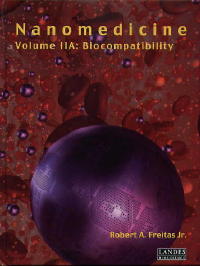Will medical nanorobots be biocompatible?
October 28, 2003 | Source: KurzweilAI
The second volume in the Nanomedicine book series by Robert A. Freitas Jr. , Nanomedicine, Vol. IIA: Biocompatibility, has been published by Landes Bioscience.
 This comprehensive technical book is timely, given the growing concerns in the environmental community about the biocompatibility of nanotechnology.
This comprehensive technical book is timely, given the growing concerns in the environmental community about the biocompatibility of nanotechnology.
It describes the many possible responses of the human body to the in vivo introduction of future medical nanorobots. Such advanced nanodevices could quickly eliminate pathogens and cancer cells, conduct molecular repairs of damaged biological structures, and restore and maintain the body in a state of youthful health, revolutionizing 21st century medicine.
It’s likely that the first medical nanorobots may be buildable 10-20 years from today using an advanced molecular manufacturing technology, predicts Freitas.
The first volume in the Nanomedicine book series, Nanomedicine, Vol. I: Basic Capabilities, published by Landes Bioscience in 1999, described manufacturing pathways for medical nanorobots and the many technical capabilities they must have to perform their medical missions.
Volume IIA extends this analysis by considering whether medical nanorobots will be biologically compatible with the human body. “The safety, effectiveness, and utility of medical nanorobotic devices will critically depend upon their biocompatibility with human organs, tissues, cells, and biochemical systems,” says Freitas.
“While classical biocompatibility has often focused on the immunological and thrombogenic reactions of the body to foreign substances placed within it, Nanomedicine Vol. IIA broadens the definition of nanomedical biocompatibility to include all of the mechanical, physiological, immunological, cytological, and biochemical responses of the human body to the introduction of medical nanodevices, whether ‘particulate’ or ‘bulk’ in form.”
The book addresses:
The book is currently available for purchase at $99 in hardcover from Amazon.com. It includes 348 pages, 6259 literature references, and an extensive index.
The full text of Nanomedicine, Vol. I (1999), is available online or for $89 in softcover from Amazon.com.